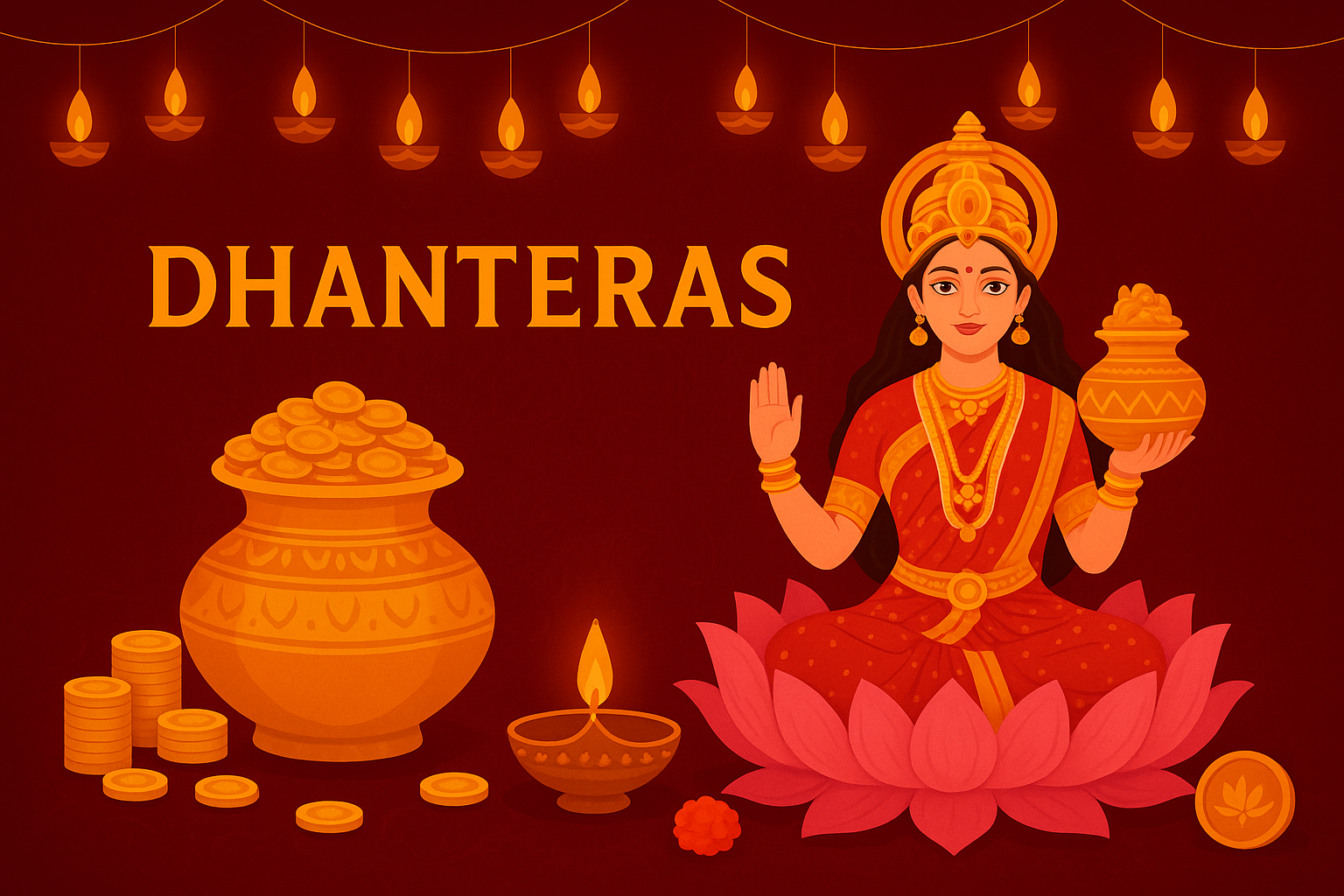What is Dhanteras?
Dhanteras marks the beginning of the five-day Diwali festival in India. It is celebrated on the thirteenth lunar day (Trayodashi) of Krishna Paksha in the Hindu month of Kartik, which usually falls in October or November. The word “Dhanteras” is derived from two Sanskrit words — “Dhan” meaning wealth and “Teras” meaning thirteenth day.
This day is also known as Dhantrayodashi, and it is considered highly auspicious for purchasing precious metals, new utensils, and valuable goods. People believe that buying such items on Dhanteras brings good fortune, prosperity, and success throughout the year.
Why It is Called Dhanteras
The name Dhanteras literally translates to “the thirteenth day of wealth.” According to Hindu tradition, this is the day when Lord Dhanvantari, the God of Ayurveda and healing, emerged from the ocean during the Samudra Manthan (churning of the cosmic ocean) carrying a pot of Amrit (nectar of immortality) and a jar of herbs that symbolize health and longevity.
Hence, this day honours Lord Dhanvantari and Goddess Lakshmi, the goddess of wealth. People pray for both good health and material prosperity, reflecting the balance between well-being and wealth — a central concept in Indian philosophy.
Importance and Significance of Dhanteras
1. Spiritual and Religious Importance
- Dhanteras sets the tone for Diwali, one of the biggest Hindu festivals.
- It is believed that worshipping Goddess Lakshmi on this day brings prosperity, happiness, and divine blessings.
- Many also perform Lakshmi Puja in the evening, lighting diyas (lamps) to welcome the goddess into their homes.
- Devotees also pray to Lord Dhanvantari for good health and long life, making Dhanteras a festival that celebrates both wealth and wellness.
2. Socio-Economic Importance
- Dhanteras has a massive economic impact across India. It’s one of the busiest shopping days of the year.
- People buy gold, silver, jewellery, coins, utensils, electronic gadgets, and vehicles, believing these purchases invite prosperity.
- The day witnesses a surge in business for jewellers, traders, and retail markets, symbolizing the cultural linkage between faith and economy.
- In rural India, farmers often buy new agricultural tools, and in urban areas, professionals invest in new assets or business equipment.
3. Cultural and Social Dimensions
- Dhanteras strengthens family bonds as people clean and decorate their homes, exchange gifts, and prepare for Diwali festivities.
- Women create rangoli designs at doorsteps, light diyas, and place Kalash (auspicious pot) filled with water and mango leaves as a sign of prosperity.
- Communities come together to celebrate, highlighting unity in diversity across different regions of India.
- In many parts of India, the evening is marked by Dhanteras Puja, where people chant hymns and offer prayers for abundance and protection from evil.
How Indians Celebrate Dhanteras
1. Buying Precious Metals and Goods
The most distinctive feature of Dhanteras is buying gold, silver, utensils, or other valuable items. Even a small silver coin or brass utensil is believed to attract wealth. Many also invest in property, vehicles, or business deals on this day as it is considered shubh (auspicious).
2. Cleaning and Decorating Homes
Homes are thoroughly cleaned, renovated, and decorated with flowers, rangolis, and lights. This act symbolizes inviting Goddess Lakshmi into one’s life and removing negativity or poverty.
3. Lighting of Diyas
As evening sets in, people light earthen lamps (diyas) to dispel darkness and evil spirits. These lamps are placed at the entrance, corners, and courtyards of homes to symbolize the triumph of light over darkness.
4. Lakshmi and Dhanvantari Puja
People perform Dhanteras Puja with devotion. They offer sweets, flowers, coins, and diyas to Goddess Lakshmi and Lord Dhanvantari. Some also worship Lord Kubera, the treasurer of wealth, seeking stability and growth.
5. Community and Family Gatherings
Families gather to share sweets, fruits, and festive dishes. Gifts are exchanged, and people visit temples or attend community prayers. In cities, markets glow with festive energy — illuminated shops, special offers, and cultural performances enhance the joy of the day.
Legends and Mythological Background
Several legends are associated with Dhanteras:
- The Legend of King Hima’s Son:
According to one myth, a young prince was destined to die from a snake bite on the fourth day of his marriage. To protect him, his wife placed gold ornaments and lamps around their room and kept him awake with stories and songs. When Yama, the god of death, arrived in the form of a serpent, he was dazzled by the brilliance of the gold and lamps and left quietly. Hence, lighting diyas on Dhanteras is believed to ward off evil and misfortune. - The Emergence of Lord Dhanvantari:
During Samudra Manthan, Lord Dhanvantari appeared with the nectar of immortality, representing health and longevity. Hence, Dhanteras is also celebrated as National Ayurveda Day in India to honour the ancient system of medicine.
Modern-Day Relevance of Dhanteras
In modern India, Dhanteras holds spiritual, cultural, and economic relevance:
- It reminds people to value health and prosperity equally.
- It promotes financial planning, savings, and investments, aligning traditional beliefs with modern economic practices.
- The festival unites Indians across religions and regions through shared celebration and positivity.
- Even in digital times, online gold purchases and e-commerce sales on Dhanteras reflect how ancient traditions adapt to modern lifestyles.
Conclusion: The Essence of Dhanteras
Dhanteras is much more than a festival of wealth — it’s a celebration of hope, renewal, and divine blessings. It reflects India’s age-old wisdom that true prosperity lies not just in riches but in good health, peace, and generosity.
As diyas glow across homes and hearts, Dhanteras reminds us that every act of faith and every purchase made with good intention can become a symbol of abundance and gratitude.

Leave a Reply